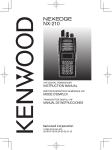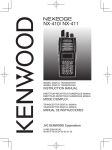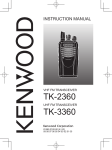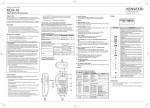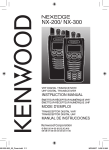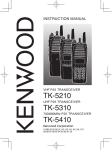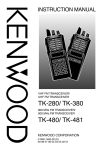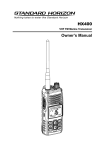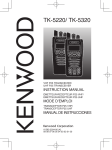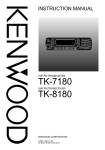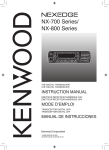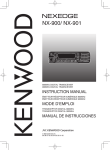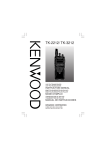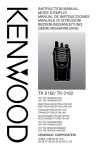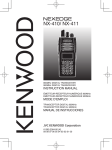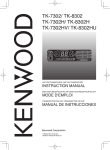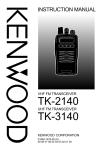Download Kenwood NX-200/300 UserGuide
Transcript
NX-200/ NX-300
NX-200G/ NX-300G
NX-200S/ NX-300S
VHF DIGITAL TRANSCEIVER/
UHF DIGITAL TRANSCEIVER
INSTRUCTION MANUAL
ÉMETTEUR-RÉCEPTEUR NUMÉRIQUE VHF/
ÉMETTEUR-RÉCEPTEUR NUMÉRIQUE UHF
MODE D’EMPLOI
TRANSCEPTOR DIGITAL VHF/
TRANSCEPTOR DIGITAL UHF
MANUAL DE INSTRUCCIONES
© B62-2608-00 (K)
09 08 07 06 05 04 03 02 01 00
NX-200/ NX-300
NX-200G/ NX-300G
NX-200S/ NX-300S
INSTRUCTION MANUAL
ENGLISH
VHF DIGITAL TRANSCEIVER/
UHF DIGITAL TRANSCEIVER
Terminal Descriptions
Universal connector
It is possible to use a resin-based cover for the Universal connector.
NO.
Name
Impedance
Description
High Impedance
I/O
1
SSW
Ext/Int Speaker Switch Input
2
SP+
BTL Output + for External Speaker
I
3
SP-
BTL Output - for External Speaker
4
MSW
Ext/Int MIC Switch Input
High Impedance
5
EMC
External MIC Input
1.8 kΩ
I
6
ME
External MIC GND
GND
-
7
PTT
External PTT Input
High Impedance
I
8
PF
Programable Function Key Input
High Impedance
I
O
8 Ω/ 16 Ω
O
I
9
OPT
Man Down Input
High Impedance
I
10
E
GND
GND
-
11
5V
5V power supply output
5V
O
12
TXD
Serial Data Output
CMOS
O
13
RXD
Serial Data Input
CMOS
I
14
NC
Not used
-
-
Antenna Terminal
50 Ω impedance
Battery Terminal
The battery terminal uses a spring plate.
The negative terminal connects to the chassis ground.
The battery is mounted on the rear side of the transceiver using a sliding mounting method.
THANK YOU
We are grateful you have chosen KENWOOD for your land
mobile radio applications.
This instruction manual covers only the basic operations of your
NEXEDGE portable radio. Ask your dealer for information on any
customized features they may have added to your radio.
NOTICES TO THE USER
◆ Government law prohibits the operation of unlicensed radio
transmitters within the territories under government control.
◆ Illegal operation is punishable by fine and/or imprisonment.
◆ Refer service to qualified technicians only.
SAFETY: It is important that the operator is aware of and
understands hazards common to the operation of any
transceiver.
i
One or more of the following statements may be applicable:
FCC WARNING
This equipment generates or uses radio frequency energy.
Changes or modifications to this equipment may cause harmful
interference unless the modifications are expressly approved in the
instruction manual. The user could lose the authority to operate this
equipment if an unauthorized change or modification is made.
INFORMATION TO THE DIGITAL DEVICE USER REQUIRED BY
THE FCC
This equipment has been tested and found to comply with the limits
for a Class B digital device, pursuant to Part 15 of the FCC Rules.
These limits are designed to provide reasonable protection against
harmful interference in a residential installation.
This equipment generates, uses and can generate radio
frequency energy and, if not installed and used in accordance
with the instructions, may cause harmful interference to radio
communications. However, there is no guarantee that the
interference will not occur in a particular installation. If this equipment
does cause harmful interference to radio or television reception,
which can be determined by turning the equipment off and on, the
user is encouraged to try to correct the interference by one or more of
the following measures:
• Reorient or relocate the receiving antenna.
• Increase the separation between the equipment and receiver.
• Connect the equipment to an outlet on a circuit different from
that to which the receiver is connected.
• Consult the dealer for technical assistance.
The RBRC Recycle seal found on KENWOOD
lithium-ion (Li-ion) battery packs indicates
KENWOOD’s voluntary participation in an industry
program to collect and recycle Li-ion batteries
after their operating life has expired. The RBRC
program is an alternative to disposing Li-ion
batteries with your regular refuse or in municipal
waste streams, which is illegal in some areas.
For information on Li-ion battery recycling in your area, call (toll
free) 1-800-8-BATTERY (1-800-822-8837).
KENWOOD’s involvement in this program is part of our commitment
to preserve our environment and conserve our natural resources.
ii
PRECAUTIONS
•
•
•
•
•
•
•
•
•
•
•
Do not charge the transceiver and battery pack when they are wet.
Ensure that there are no metallic items located between the
transceiver and the battery pack.
Do not use options not specified by KENWOOD.
If the die-cast chassis or other transceiver part is damaged, do not
touch the damaged parts.
If a headset or headphone is connected to the transceiver, reduce
the transceiver volume. Pay attention to the volume level when
turning the squelch off.
Do not place the microphone cable around your neck while near
machinery that may catch the cable.
Do not place the transceiver on unstable surfaces.
Ensure that the end of the antenna does not touch your eyes.
When the transceiver is used for transmission for many hours, the
radiator and chassis will become hot. Do not touch these locations
when replacing the battery pack.
Always switch the transceiver power off before installing optional
accessories.
The charger is the device that disconnects the unit from the AC
mains line. The AC plug should be readily accessible.
iii
Turn the transceiver power off in the following locations:
• Near explosives or blasting sites.
• In aircrafts. (Any use of the transceiver must follow the
instructions and regulations provided by the airline crew.)
• Where restrictions or warnings are posted regarding the use of
radio devices, including but not limited to medical facilities.
• Near persons wearing pacemakers.
Turn the transceiver power off in the following locations,
unless the model is specifically qualified for such use
(Intrinsically Safe such as approved by Factory Mutual, CSA):
• In explosive atmospheres (inflammable gas, dust particles,
metallic powders, grain powders, etc.).
• While taking on fuel or while parked at gasoline service stations.
•
•
Do not remove the black sheet from the reverse side of the
transceiver (refer to the illustration below). Removal of this
sheet decreases the waterproof efficiency of the transceiver and
may cause malfunctions if water seeps into the transceiver.
The orange seal on the reverse side of the transceiver is
important with respect to the waterproof efficiency of the
transceiver. Do not place stickers or other materials on or
around the seal shown in the figure, or on the reverse side of
the battery pack. Doing so will impair the waterproof efficiency
of the transceiver and may cause it to break down. Additionally,
in order to prevent damage to the seal, do not allow it to come
in contact with foreign materials.
iv
•
•
•
•
•
•
•
•
Do not disassemble or modify the transceiver for any reason.
Do not place the transceiver on or near airbag equipment while
the vehicle is running. When the airbag inflates, the transceiver
may be ejected and strike the driver or passengers.
Do not transmit while touching the antenna terminal or if
any metallic parts are exposed from the antenna covering.
Transmitting at such a time may result in a high-frequency burn.
If an abnormal odor or smoke is detected coming from the
transceiver, switch the transceiver power off immediately,
remove the battery pack from the transceiver, and contact your
KENWOOD dealer.
Use of the transceiver while you are driving may be against
traffic laws. Please check and observe the vehicle regulations
in your area.
Do not expose the transceiver to extremely hot or cold
conditions.
Do not carry the battery pack (or battery case) with metal
objects, as they may short the battery terminals.
Danger of explosion if the battery is incorrectly replaced;
replace only with the same type.
v
INFORMATION CONCERNING THE LI-ION BATTERY PACK
The battery pack includes flammable objects such as organic solvent.
Mishandling may cause the battery to rupture producing flames or
extreme heat, deteriorate, or cause other forms of damage to the
battery. Please observe the following prohibitive matters.
•
•
•
•
•
Do not disassemble or reconstruct battery!
The battery pack has a safety function and protection circuit to
avoid danger. If they suffer serious damage, the battery may
generate heat or smoke, rupture, or burst into flame.
Do not short-circuit the battery!
Do not join the + and – terminals using any form of metal (such
as a paper clip or wire). Do not carry or store the battery pack
in containers holding metal objects (such as wires, chainnecklace or hairpins). If the battery pack is short-circuited,
excessive current will flow and the battery may generate heat
or smoke, rupture, or burst into flame. It will also cause metal
objects to heat up.
Do not incinerate or apply heat to the battery!
If the insulator is melted, the gas release vent or safety function
is damaged, or the electrolyte is ignited, the battery may
generate heat or smoke, rupture, or burst into flame.
Do not leave the battery near fires, stoves, or other heat
generators (areas reaching over 80°C/ 176°F)!
If the polymer separator is melted due to high temperature,
an internal short-circuit may occur in the individual cells and
the battery may generate heat or smoke, rupture, or burst into
flame.
Avoid immersing the battery in water or getting it wet by
other means!
If the battery becomes wet, wipe it off with a dry towel before
use. If the battery’s protection circuit is damaged, the battery
may charge at extreme current (or voltage) and an abnormal
chemical reaction may occur. The battery may generate heat or
smoke, rupture, or burst into flame.
vi
•
•
•
•
•
•
•
Do not charge the battery near fires or under direct
sunlight!
If the battery’s protection circuit is damaged, the battery may
charge at extreme current (or voltage) and an abnormal
chemical reaction may occur. The battery may generate heat or
smoke, rupture, or burst into flame.
Use only the specified charger and observe charging
requirements!
If the battery is charged in unspecified conditions (under high
temperature over the regulated value, excessive high voltage
or current over regulated value, or with a remodelled charger),
it may overcharge or an abnormal chemical reaction may occur.
The battery may generate heat or smoke, rupture, or burst into
flame.
Do not pierce the battery with any object, strike it with an
instrument, or step on it!
This may break or deform the battery, causing a short-circuit.
The battery may generate heat or smoke, rupture, or burst into
flame.
Do not jar or throw the battery!
An impact may cause the battery to leak, generate heat
or smoke, rupture, and/or burst into flame. If the battery’s
protection circuit is damaged, the battery may charge at an
abnormal current (or voltage), and an abnormal chemical
reaction may occur.
Do not use the battery pack if it is damaged in any way!
The battery may generate heat or smoke, rupture, or burst into
flame.
Do not solder directly onto the battery!
If the insulator is melted or the gas release vent or safety
function is damaged, the battery may generate heat or smoke,
rupture, or burst into flame.
Do not reverse the battery polarity (and terminals)!
When charging a reversed battery, an abnormal chemical
reaction may occur. In some cases, an unexpected large
amount of current may flow upon discharging. The battery may
generate heat or smoke, rupture, or burst into flame.
vii
•
•
•
•
•
•
Do not reverse-charge or reverse-connect the battery!
The battery pack has positive and negative poles. If the battery
pack does not smoothly connect with a charger or operating
equipment, do not force it; check the polarity of the battery. If
the battery pack is reverse-connected to the charger, it will be
reverse-charged and an abnormal chemical reaction may occur.
The battery may generate heat or smoke, rupture, or burst into
flame.
Do not touch a ruptured and leaking battery!
If the electrolyte liquid from the battery gets into your eyes,
wash your eyes out with fresh water as soon as possible,
without rubbing your eyes. Go to the hospital immediately. If
left untreated, it may cause eye-problems.
Do not charge the battery for longer than the specified
time!
If the battery pack has not finished charging even after the
regulated time has passed, stop it. The battery may generate
heat or smoke, rupture, or burst into flame.
Do not place the battery pack into a microwave or high
pressure container!
The battery may generate heat or smoke, rupture, or burst into
flame.
Keep ruptured and leaking battery packs away from fire!
If the battery pack is leaking (or the battery emits a bad odor),
immediately remove it from flammable areas. Electrolyte
leaking from battery can easily catch on fire and may cause the
battery to generate smoke or burst into flame.
Do not use an abnormal battery!
If the battery pack emits a bad odor, appears to have different
coloring, is deformed, or seems abnormal for any other reason,
remove it from the charger or operating equipment and do not
use it. The battery may generate heat or smoke, rupture, or
burst into flame.
viii
CONTENTS
UNPACKING AND CHECKING EQUIPMENT ..............................1
SUPPLIED ACCESSORIES ...............................................................1
PREPARATION ............................................................................2
INSTALLING/ REMOVING THE (OPTIONAL) BATTERY PACK ....................2
INSTALLING THE (OPTIONAL) ANTENNA ............................................2
INSTALLING THE BELT CLIP ............................................................3
INSTALLING THE CAP OVER THE UNIVERSAL CONNECTOR ...................3
INSTALLING THE (OPTIONAL) SPEAKER/ MICROPHONE OR HEADSET ......3
GETTING ACQUAINTED .............................................................4
DISPLAY .....................................................................................7
PROGRAMMABLE FUNCTIONS ..................................................8
BASIC OPERATIONS .................................................................12
SWITCHING POWER ON/ OFF ....................................................12
ADJUSTING THE VOLUME .............................................................12
SELECTING A ZONE AND CHANNEL/GROUP ID ................................13
TRANSMITTING...........................................................................13
RECEIVING................................................................................14
MENU MODE (NX-200/ NX-300/ NX-200G/ NX300G ONLY) ......15
MENU ACCESS ..........................................................................15
MENU CONFIGURATION ...............................................................15
CHARACTER ENTRY ...................................................................17
SCAN...........................................................................................18
TEMPORARY CHANNEL LOCKOUT ..................................................18
PRIORITY SCAN .........................................................................18
SCAN REVERT ..........................................................................19
SCAN DELETE/ADD ....................................................................19
PRIORITY-CHANNEL SELECT
(NX-200/ NX-300/ NX-200G/ NX-300G ONLY) .......................19
FleetSync: ALPHANUMERIC 2-WAY PAGING FUNCTION ......20
SELCALL (SELECTIVE CALLING) ....................................................20
STATUS MESSAGE .....................................................................21
SHORT/LONG MESSAGES ............................................................22
ix
GPS REPORT ..........................................................................22
ADVANCED OPERATIONS ........................................................23
DTMF (DUAL TONE MULTI FREQUENCY) CALLS ............................23
TRUNKING CALLS ......................................................................24
EMERGENCY CALLS ...................................................................25
SCRAMBLER ..............................................................................25
SIGNALING ................................................................................26
VOICE OPERATED TRANSMISSION (VOX) ......................................27
BACKGROUND OPERATIONS ..................................................29
CLOCK (NX-200/ NX-300/ NX-200G/ NX-300G ONLY) ...........29
VIBRATOR.................................................................................29
TIME-OUT TIMER (TOT) .............................................................29
BATTERY SAVER........................................................................30
KEY LOCK ................................................................................30
LOW BATTERY WARNING (NX-200S/ NX-300S) ..........................30
LOW BATTERY WARNING
(NX-200/ NX-300/ NX-200G/ NX-300G) ...............................30
SIGNAL STRENGTH INDICATOR
(NX-200/ NX-300/ NX-200G/ NX-300G ONLY) .......................30
COMPANDER .............................................................................31
BUSY CHANNEL LOCKOUT (BCL).................................................31
CONTROL CHANNEL HUNT...........................................................31
PTT ID ...................................................................................31
VGS-1 OPTIONAL VOICE GUIDE & STORAGE UNIT...............32
VOICE RECORDER .....................................................................32
VOICE GUIDE ............................................................................33
x
UNPACKING AND CHECKING EQUIPMENT
Note: These unpacking instructions are for use by your KENWOOD
dealer, an authorized KENWOOD service facility, or the factory.
Carefully unpack the transceiver. We recommend that you
identify the items listed in the following list before discarding
the packing material. If any items are missing or damaged, file
a claim with the carrier immediately.
SUPPLIED ACCESSORIES
Belt clip . . . . . . . . . . . . . . . . . . . . . . . . . . . . . . . . . . . . . . . . . . . . . . . .
• Screws for belt clip (M3 x 8 mm) . . . . . . . . . . . . . . . . . . . . . . . . . .
Universal connector cap . . . . . . . . . . . . . . . . . . . . . . . . . . . . . . . . . . .
• Dressing screw (preassembled) . . . . . . . . . . . . . . . . . . . . . . . . . .
• Packing (preassembled) . . . . . . . . . . . . . . . . . . . . . . . . . . . . . . . .
Instruction manual . . . . . . . . . . . . . . . . . . . . . . . . . . . . . . . . . . . . . . . .
1
1
2
1
1
1
1
PREPARATION
INSTALLING/ REMOVING THE (OPTIONAL) BATTERY PACK
1
2
3
Match the guides of the
battery pack with the grooves
on the upper rear of the
transceiver, then firmly press
the battery pack in place.
Lock the safety catch to
prevent accidentally releasing
the battery pack.
To remove the battery pack,
lift the safety catch, press the
release latch, then pull the
battery pack away from the
transceiver.
1
2
3
Note:
◆ For battery pack charging procedures and useage, refer to the
battery charger Instruction Manual.
◆ Before charging a battery pack that is attached to the
transceiver, ensure that the safety catch is firmly closed.
◆ While operating the transceiver using a Li-ion battery pack in
areas with an ambient temperature of –10°C/ +14°F and lower,
operating time may be shortened.
◆ Install the battery pack after cleaning the battery pack contacts
and the transceiver terminals.
INSTALLING THE (OPTIONAL) ANTENNA
Screw the antenna into the
connector on the top of the
transceiver by holding the
antenna at its base and turning
it clockwise until secure.
2
Optional
antenna
INSTALLING THE BELT CLIP
Belt clip
Attach the belt clip using the
supplied M3 x 8 mm screws.
Note: If the belt clip is not
installed, its mounting location
may get hot during continuous
transmission or when left sitting in
a hot environment.
M3 x 8 mm screws
Do not use glue which is designed to prevent screw loosening when
installing the belt clip. Acrylic ester, which is contained in these
glues, may crack the transceiver’s back panel.
INSTALLING THE CAP OVER THE UNIVERSAL CONNECTOR
Insert the cap into place over the
universal connector and secure
it in place using the attached
screw.
Universal
connector cap
M
IC
INSTALLING THE (OPTIONAL) SPEAKER/ MICROPHONE OR HEADSET
1
2
Insert the guide of the
speaker/ microphone or
headset connector into place
over the universal connector.
Secure the connector in place
using the attached screw.
Note: When not using an optional
speaker/ microphone or headset,
install the cap over the universal
connector.
M
IC
Optional
speaker/ microphone
1
4
GH
I
7
PQ
RS
2 ABC
5JKL
8 TUV
0
3 DEF
6 MNO
9 WXYZ
#
3
GETTING ACQUAINTED
NX-200S/ NX-300S
a Selector knob
Rotate to select a zone or channel/group ID (default).
b Power switch/ Volume control
Rotate to turn the transceiver ON/OFF and to adjust the volume.
c Auxiliary key
Press to activate its programmable function {page 8}.
d Transmit/ Receive/ Battery low indicator
If enabled by your dealer, lights red while transmitting,
green while receiving a call (Conventional channels only),
and orange when receiving an optional signaling call. Blinks
red when the battery power is low while transmitting.
e PTT (Push-To-Talk) switch
Press and hold this switch, then speak into the microphone
to call a station.
f Side 1 key
Press to activate its programmable function {page 8}. The
default is Squelch Off Momentary.
g Side 2 key
Press to activate its programmable function {page 8}.
h Universal connector
Connect a speaker/ microphone or headset here {page 3}.
Otherwise, keep the supplied cap in place.
4
NX-200/ NX-300/ NX-200G/ NX-300G
MIC
1
4
3
2
DEF
ABC
O
GHI
7 PQR
6 MN
5
JKL
8
TUV
YZ
9 WX
S
#
0
a Selector knob
Rotate to select a zone or channel/group ID (default).
b Power switch/ Volume control
Rotate to turn the transceiver ON/OFF and to adjust the volume.
c Auxiliary key
Press to activate its programmable function {page 10}.
d Transmit/ Receive/ Battery low indicator
If enabled by your dealer, lights red while transmitting,
green while receiving a call (Conventional channels only),
and orange when receiving an optional signaling call
(2-tone, DTMF signaling, etc.). Blinks red when the battery
power is low while transmitting.
e PTT (Push-To-Talk) switch
Press and hold this switch, then speak into the microphone
to call a station.
f Side 1 key
Press to activate its programmable function {page 10}. The
default is Squelch Off Momentary.
g Side 2 key
Press to activate its programmable function {page 10}. The
default is Backlight.
5
h Keypad (keypad models only)
Press these keys to send DTMF tones. These keys can
also be programmed with secondary functions {page 10} if
a programmable function key is programmed as “Function”.
key
i
Press to activate its programmable function {page 10}. The
default is Menu.
key
j
Press to activate its programmable function {page 10}. The
default is Zone Up.
key
k
Press to activate its programmable function {page 10}.
l
key
Press to activate its programmable function {page 10}.
key
m
Press to activate its programmable function {page 10}. The
default is Zone Down.
n
key
Press to activate its programmable function {page 10}.
o Universal connector
Connect a speaker/ microphone or headset here {page 3}.
Otherwise, keep the supplied cap in place.
6
DISPLAY
Indicator
Description
Monitor or Squelch Off is activated.
Blinks when an incoming call matches your Optional
Signaling.
The current zone (left icon) or CH/GID (right icon) is
added to scan.
Scan is in progress. Blinks while scan is paused.
A message is stored in memory. Blinks when a new
message has arrived.
The current channel is a Priority channel.
Operator Selectable Tone (OST) is activated.
Appears when the selected group is programmed as
telephone IDs. Blinks during Auto Telephone search.
Signal strength indicator {page 30}.
Battery power indicator {page 30}.
Talk Around is activated.
Site Lock is activated.
Scrambler/ Encryption is activated.
Auto Recording on the VGS-1 option is activated.
Auto Reply Message on the VGS-1 option is activated.
The auxiliary function is activated.
Lone Worker is activated.
The channel is using high transmit power. “L” appears
when using low transmit power.
VOX is activated.
The vibrator is activated. Blinks when inhibited.
Displays the time.
Displays the key functions for
,
, and
.
7
PROGRAMMABLE FUNCTIONS
Following is a list of available programmable functions. Please
contact your dealer for further details on those functions which
have been programmed on your transceiver.
PROGRAMMABLE FUNCTIONS FOR NX-200S/ NX-300S
•
•
•
•
•
•
•
•
•
•
•
•
•
•
•
•
•
•
•
•
•
Auto Telephone 2
AUX
Battery Indicator
Broadcast 3
Call 1 ~ 6
CH/GID Down
CH/GID Select 4
CH/GID Recall
CH/GID Up
CW Message 5
Direct CH/GID 1 ~ 5
Direct CH/GID Select 1 ~ 5
Emergency 6
Fixed Volume
Forced Search Function 3, 10
Function
High Transmit Power 3
Home CH/GID
Home CH/GID Select
Key Lock
Lone Worker
8
•
•
•
•
•
•
•
•
•
•
•
•
•
•
•
•
•
•
•
•
•
•
•
Low Transmit Power
Monitor 7
Monitor Momentary 7
Scan
Scan Delete/Add
Scrambler/Encryption 10
Send the GPS data
Site Down 3
Site Lock 3, 10
Site Select 4
Site Up 3
Site Up/Down 4
Speaker Attenuation 9
Squelch Off 1
Squelch Off Momentary 1
Talk Around 7
Telephone Disconnect 2
Vibrator
VOX Function 8, 10
Zone Delete/Add
Zone Down
Zone Select 4
Zone Up
Available only for Analog Conventional operation.
Available only for Analog Trunking operation.
3
Available only for NXDN Trunking operation.
4
Can be programmed only on the Selector knob.
5
Available only for NXDN Conventional operation.
6
Can be programmed only on the Auxiliary key and the optional
speaker/ microphone PF1 (orange) key.
7
Available only for Analog Conventional, Analog Trunking, and NXDN
Conventional operation.
8
Available only for Analog Conventional and NXDN Conventional
operation.
9
Can be programmed only on the microphone programmable function
keys.
10
Available only for ON/ OFF operation.
1
2
9
PROGRAMMABLE FUNCTIONS FOR
NX-200/ NX-300/ NX-200G/ NX-300G
•
•
•
•
•
•
•
•
•
•
•
•
•
•
•
•
•
•
•
•
•
•
•
•
•
•
•
•
•
•
•
•
•
•
2-tone 1
Auto Reply Message 2
Auto Telephone 3
Autodial
Autodial Programming
AUX
Backlight
Broadcast 5
Call 1 ~ 6
CH/GID Down
Channel Entry
CH/GID Select 6
CH/GID Recall
CH/GID Up
Clock
Clock Adjustment
CW Message 7
Direct CH/GID 1 ~ 5
Direct CH/GID Select 1 ~ 5
Display Format
Emergency 8
Fixed Volume
Forced Search 5
Function
GPS Position Display
Group ID/Channel Entry
Group (NXDN) 7
Group + SDM (NXDN) 9
Group + Status (NXDN) 9
High Transmit Power 5
Home CH/GID
Home CH/GID Select
Individual (NXDN) 9
Individual + SDM (NXDN) 9
10
•
•
•
•
•
•
•
•
•
•
•
•
•
•
•
•
•
•
•
•
•
•
•
•
•
•
•
•
•
•
•
•
•
•
Individual + Status (NXDN) 9
Key Lock
Lone Worker
Low Transmit Power
Maintenance
Menu
Monitor 4
Monitor Momentary 4
Operator Selectable Tone 1
Playback 2
Priority-channel Select 11
Scan
Scan Delete/Add
Scrambler/Encryption
Scramber/Encryption Code
SDM (FleetSync/NXDN)
Selcall (FleetSync) 10
Selcall + SDM (FleetSync) 10
Selcall + Status (FleetSync)10
Send the GPS data
Site Down 5
Site Lock 5
Site Select 6
Site Up 5
Site Up/Down 5, 6
Speaker Attenuation 12
Squelch Level 1
Squelch Off 1
Squelch Off Momentary 1
Stack
Status (FleetSync/ NXDN)
Talk Around 4
Telephone Disconnect 3
Transceiver Password
•
•
•
•
Vibrator
Voice Memo 2
VOX 11
Zone Delete/Add
•
•
•
Zone Down
Zone Select 6
Zone Up
Available only for Analog Conventional operation.
Available only if the VGS-1 optional board has been installed.
3
Available only for Analog Trunking operation.
4
Available only for Analog Conventional, Analog Trunking, and NXDN
Conventional operation.
5
Available only for NXDN Trunking operation.
6
Can be programmed only on the Selector knob.
7
Available only for NXDN Conventional operation.
8
Can be programmed only on the Auxiliary key and the optional
speaker/ microphone PF1 (orange) key.
9
Available only for NXDN Conventional and NXDN Trunking operation.
10
Available only for Analog Conventional and Analog Trunking
operation.
11
Available only for Analog Conventional and NXDN Conventional
operation.
12
Can be programmed only on the microphone programmable function
keys.
1
2
11
BASIC OPERATIONS
SWITCHING POWER ON/OFF
Turn the Power switch/ Volume control clockwise to switch the
transceiver ON.
Turn the Power switch/ Volume control counterclockwise fully
to switch the transceiver OFF.
■ Transceiver Password
(NX-200/ NX-300/ NX-200G/ NX-300G Only)
If the transceiver is password protected, “PASSWORD” will
appear on the display when the power is turned ON. To
unlock the transceiver, enter the password:
/
.
1 Select a character using
•
2
•
3
to enter the selected character.
This step is unnecessary when using the keypad.
Repeat steps 1 and 2 to enter the entire password.
•
4
On keypad models, you can enter the password directly.
Press
Press
or # to delete a character. Press and hold
# to delete all characters.
Press
•
•
or
or
to confirm the entry.
If you enter an incorrect password, an error tone sounds
and the transceiver remains locked.
The password can contain a maximum of 6 digits.
ADJUSTING THE VOLUME
Rotate the Power switch/ Volume control to adjust the volume.
Clockwise increases the volume and counterclockwise
decreases it.
SELECTING A ZONE AND CHANNEL/GROUP ID
Select the desired zone using the key programmed as Zone
Select or Zone Up/Down. Each zone contains a group of
channels.
12
Select the desired channel/group ID using the Selector knob
(default). Each channel/group ID is programmed with settings
for transmitting and receiving.
•
You can toggle the display between the zone and channel/group
ID names and number by pressing the key programmed as Display
Format, or by accessing the Menu (NX-200/ NX-200G/ NX-300/
NX-300G Only) {page 15}.
Note: If the default settings for
/
(NX-200/ NX-200G/
NX-300/ NX-300G Only) and the Selector knob have been changed,
use the appropriate keys to select the zone and channel/group ID.
TRANSMITTING
1
2
Select the desired zone and channel/group ID.
Press the key programmed as Monitor or Squelch Off to
check whether or not the channel is free.
3
Press the PTT switch and speak into the microphone.
Release the PTT switch to receive.
•
•
If the channel is busy, wait until it becomes free.
For best sound quality, hold the transceiver approximately
1.5 inches (3 ~ 4 cm) from your mouth.
■ Making Group Calls (Digital)
(NX-200/ NX-300/ NX-200G/ NX-300G Only)
If a key has been programmed with Group or Group +
Status, you can select a group ID from the list to make a
call to those parties on a Conventional channel.
To select a group ID:
1 Press the key programmed as Group or Group + Status.
2 Press
/
to select a group ID/name from the list.
3 Press and hold the PTT switch to make the call.
•
Speak into the transceiver as you would during a normal
transmission.
13
■ Making Individual Calls (Digital)
(NX-200/ NX-300/ NX-200G/ NX-300G Only)
If a key has been programmed with Individual or
Individual + Status, you can make calls to specific
persons.
1 Press the key programmed as Individual or
Individual + Status.
2 Press
/
to select a unit ID from the list.
•
3
On keypad models, you can enter a unit ID directly.
Press and hold the PTT switch to make the call.
•
Speak into the transceiver as you would during a normal
transmission.
RECEIVING
Select the desired zone and channel. If signaling has been
programmed on the selected channel, you will hear a call only
if the received signal matches your transceiver settings.
Note: Signaling allows your transceiver to code your calls. This will
prevent you from listening to unwanted calls. Refer to “SIGNALING”
on page 26 for details.
■ Receiving Group Calls (Digital)
When you receive a group call on a Conventional channel
and the received group ID matches the ID set up on your
transceiver, you can hear the caller’s voice.
When you receive a group call on a Trunking channel, the
transceiver automatically switches to the communications
channel to receive the call.
■ Receiving Individual Calls (Digital)
When you receive an individual call, a ringing tone will sound
and the caller’s ID will appear on the display (NX-200/ NX-200G
/NX-300/ NX-300G Only). To respond to the call, press and
hold the PTT switch and speak into the transceiver as you
would during a normal transmission.
14
MENU MODE (NX-200/ NX-300/ NX-200G/ NX-300G ONLY)
Many functions on this transceiver are selected or configured through
the Menu instead of physical controls. Once you become familiar with
the Menu system, you will appreciate the versatility it offers.
MENU ACCESS
1
Press the key programmed as Menu.
2
Press
3
4
5
6
7
•
•
The category list is shown.
When there is only 1 category, the function list is shown (proceed to step 4).
/
to select a category item.
•
On keypad models, you can enter a category number directly.
Press
or
to view the function list.
Press
/
to select a function item.
•
On keypad models, you can enter a function number directly.
Press
or
to set up the selected function item.
• Press
or # to return to the category list.
Press
/
to select your desired setting.
•
For settings with more than 1 level, repeat steps 5 and 6.
Press
or
to set the selected setting and exit Menu mode.
• Press
or # at any time to return to the previous display.
• Press
at any time to exit Menu mode.
MENU CONFIGURATION
Some transceiver keys may already be programmed with
functions listed in the Menu. Those functions can be accessed
directly by pressing the key. All other functions can still be
accessed using the transceiver Menu. The following table lists
the available Menu items.
Display
Description
2-TONE
2-tone Mode
AUTO REPLY MSG
Auto Reply Message ON/OFF
AUTO TELEPHONE
Auto Telephone
AUTO DIAL
Autodial Mode
AUTO DIAL PROG
Autodial Programming Mode
AUX
AUX ON/OFF
BROADCAST
Broadcast ON/OFF
15
Display
Description
CLOCK
Clock ON/OFF
CLOCK ADJUST
Clock Adjustment mode
DIRECT CH1 SEL
Direct CH/GID 1 ~ 5 Select
DISP FORMAT
Display Format ON/OFF
EXT MIC TYPE
External Microphone Type mode
FIXED VOLUME
Fixed Volume
FORCED SEARCH
Forced Search
GPS POS DISP
GPS Position Display mode
GROUP
Group mode
GROUP+STATUS
Group + Status mode
GROUP+SDM
Group + SDM mode
HIGH TX POWER
High Transmisson Power ON/OFF
HOME CH SEL
Home CH/GID Select
INDIVIDUAL
Individual mode
INDIV+STATUS
Individual + Status mode
INDIV+SDM
Individual + SDM mode
LONE WORKER
Lone Worker ON/OFF
LOW TX POWER
Low Transmission Power ON/OFF
MAINTENANCE
Maintenance Display mode
MONITOR
Monitor ON/OFF
OST
OST ON/OFF
OST LIST
OST mode
PLAYBACK
Playback mode
PRI CH SEL
Priority Channel Select mode
RX AUDIO EQ
RX Audio Equalizer mode
RX AGC
RX Audio Gain Control mode
RX LOW CUT
RX Low Cut mode
SCAN
Scan ON/OFF
SCAN DEL/ADD
Scan Delete/Add
SCRAM/ENCRYP
Scrambler/Encryption ON/OFF
SCRAM CODE
Scrambler/Encryption Code mode
SELCALL
Selcall mode
SELCALL+STATUS
Selcall + Status mode
SELCALL+SDM
Selcall + SDM mode
SEND GPS DATA
Transmit your GPS data
SITE LOCK
Site Lock ON/OFF
16
Display
Description
SITE No.
Display Site Number
SITE
Site Select Mode
SQUELCH LEVEL
Squelch Level mode
SQUELCH OFF
Squelch Off ON/OFF
STACK
Stack mode
STATUS
Status mode
SHORT MESSAGE
Short Message mode
TALK AROUND
Talk Around ON/OFF
TX AUDIO EQ
TX Audio Equalizer mode
TX AGC
TX Audio Gain Control mode
TX NOISE SUPPR
TX Noise Suppressor mode
PASSWORD
Transceiver Password mode
VIBRATOR
Vibrator ON/OFF
VOICE MEMO
Voice Memo mode
VOX LEVEL
VOX Level mode
VOX
VOX ON/OFF
ZONE DEL/ADD
Zone Delete/Add
CHARACTER ENTRY
There are 2 methods available for entering characters:
/
keys
1) Pressing the
Press
/
to cycle the characters from A ~ Z, 0 ~ 9,
and a space (default settings).
You can also assign a character to an optional key and
later press that key to recall the assigned character: A ~ Z,
a ~ z, 0 ~ 9, or a space and characters.
2) Using the DTMF keypad
Press the keypad keys to enter characters as shown in the
table below:
DTMF Key Character Cycle DTMF Key Character Cycle
1
1
6
M N O 6
2
A B C 2
7
P Q R S 7
3
D E F 3
8
T U V 8
4
G H I 4
9
W X Y Z 9
5
J K L 5
0
[space] 0
17
SCAN
Scan monitors for signals on the transceiver channels. While
scanning, the transceiver checks for a signal on each channel
and only stops if a signal is present.
To begin scanning, press the key programmed as Scan.
•
•
•
The icon appears on the display (NX-200/ NX-300/ NX-200G/
NX-300G Only).
The LED blinks green (NX-200S/ NX-300S Only).
When a signal is detected on a channel, Scan pauses at that
channel. The transceiver will remain on the busy channel until the
signal is no longer present, at which time Scan resumes.
To stop scanning, press the Scan key again.
Note: To use Scan, there must be at least 2 channels in the scan
sequence.
TEMPORARY CHANNEL LOCKOUT
During scan, you can temporarily remove specific channels
from the scanning sequence by selecting them and pressing
the key programmed as Scan Delete/Add.
•
The channel is no longer scanned. However, when scanning is
ended and restarted, the channels are reset and deleted channels
will again be in the scanning sequence.
PRIORITY SCAN
Note: To use Priority Scan, a Priority channel must be programmed.
When using a single Priority channel, the transceiver will
automatically change to the Priority channel when a call is
received on that channel, even if a call is being received on a
normal channel.
When using dual Priority channels, Priority channel 1 is given
precedence over Priority channel 2. So, if a call is received on
Priority channel 1 while a call is already on Priority channel 2,
the transceiver will change to Priority channel 1.
18
SCAN REVERT
The Scan Revert channel is the channel selected when you
press the PTT switch to transmit during scan. Your dealer can
program one of the following types of Scan Revert channels:
• Selected: The last channel selected before scan.
• Selected + Talkback: Same as “Selected”, plus you can
respond to calls on the channel at which scan is paused.
• Priority 1/ Priority 2: The Priority channel (either Priority 1
or Priority 2) .
• Priority 1 + Talkback/ Priority2 + Talkback: Same as
“Priority 1/ Priority 2”, plus you can respond to calls on the
channel at which scan is paused.
• Last Called + Selected: The last channel on which you
receive a call.
SCAN DELETE/ADD
You can add and remove zones and/or channels/group IDs to
and from your scan list.
1 Select your desired zone and/or channel/group ID.
2 Press the key programmed as Zone Delete/Add (to
add/remove zones) or Scan Delete/Add (to add/remove
channels/group IDs) (NX-200/ NX-200G/ NX-300/
NX-300G Only).
•
You can also press and hold the key programmed as Scan
Delete/Add to add/remove zones.
PRIORITY-CHANNEL SELECT
(NX-200/ NX-300/ NX-200G/ NX-300G ONLY)
If the Priority channel has been set as Operator Selectable by
your dealer, you can reprogram the Priority channels.
1 Select your desired zone and channel/group ID.
2 Press the key programmed as Priority-channel Select.
3 Press
/
to select “NORMAL”, “PRIORITY 1” (
),
“PRIORITY 2” (
), or “PRIORITY 1&2” (
).
4 Press
to save the setting and exit.
19
FleetSync: ALPHANUMERIC 2-WAY PAGING FUNCTION
FleetSync is an Alphanumeric 2-way Paging Function, and is a
protocol owned by JVC KENWOOD Corporation.
Note:
◆ This function is available only in analog operation.
◆ Ask your dealer for further information regarding the
NX-200S/ NX-300S.
SELCALL (SELECTIVE CALLING)
A Selcall is a voice call to a station or group of stations.
■ Transmitting (NX-200/ NX-300/ NX-200G/ NX-300G Only)
1
2
3
Select your desired zone and channel.
Press the key programmed as Selcall or Selcall +
Status to enter Selcall mode.
/
to select the station you want to call.
Press
•
4
On keypad models, if Manual Dialing is enabled, you can
directly enter the station ID.
Press the PTT switch and begin your conversation.
■ Receiving
An alert tone will sound and the transceiver will enter
Selcall mode. The calling station’s ID will appear when a
Selcall is received (NX-200/ NX-300/ NX-200G/ NX-300G
Only). You can respond to the call by pressing the PTT
switch and speaking into the microphone.
■ Identification Codes
An ID code is a combination of a 3-digit Fleet number and a
4-digit ID number. Each transceiver has its own ID.
•
•
•
•
Enter a Fleet number (100 ~ 349) to make a group call.
Enter an ID number (1000 ~ 4999) to make an individual call in
your fleet.
Enter a Fleet number to make a call to all units in the selected
fleet (Fleet call).
Enter an ID number to make a call to the selected ID in all
fleets (Supervisor call).
20
•
Select “ALL” Fleet and “ALL” ID to make a call to all units
(Broadcast call).
STATUS MESSAGE
You can send and receive 2-digit Status messages which may
be decided in your talk group. Messages can contain up to 16
alphanumeric characters. Status messages range from 10 to
99 (80 ~ 99 are reserved for special messages).
A maximum of 15 received messages (combined status
messages and short messages) can be stored in the stack
memory of your transceiver.
■ Transmitting (NX-200/ NX-300/ NX-200G/ NX-300G Only)
1
2
3
Select your desired zone and channel.
Press the key programmed as Status to enter Status
mode (proceed to step 5) or Selcall + Status to enter
Selcall mode (proceed to step 3).
/
to select the station you want to call.
Press
•
4
5
Press
Press
•
6
If Manual Dialing is enabled, you can enter a station ID
by using the DTMF keypad, or by using
/
. When
using
/
, cycle through the digits to select a digit,
then press
to set the digit and move the cursor to the
right. Repeat this process until the entire ID is entered.
to enter Status mode.
/
to select the status you want to transmit.
If Manual Dialing is enabled, you can enter a status ID by
using the DTMF keypad, or by using
/
(refer to
step 3, above).
Press the PTT switch or Side 2 key to initiate the call.
•
“<COMPLETE>” appears on the display when the status
has been successfully transmitted.
■ Receiving
A calling ID or text message will appear when a Status call
is received (NX-200/ NX-300/ NX-200G/ NX-300G Only).
Press any key to return to normal operation.
21
■ Reviewing Messages in the Stack Memory
(NX-200/ NX-300/ NX-200G/ NX-300G Only)
1
Press the key programmed as Stack, or press and hold
the key programmed as Selcall, Status, or Selcall +
Status to enter Stack mode.
2
Press
•
•
•
The last received message is displayed.
3 Press
•
•
/
to select the desired message.
Message types are identified as follows:
I: Caller ID, S: Status Message, M: Short Message
for 1 second or press
to cycle the
Press and hold
display information as follows:
ID Name > Status/Short Message > CH/GID > Time Stamp
to return to normal operation.
To delete the selected message, press
To confirm the deletion, press
or .
To delete all messages, press and hold
To confirm the deletion, press
or .
or #.
or # for 1 second.
SHORT/LONG MESSAGES
Received short messages are displayed the same as Status
messages and are stored in the same stack memory (NX-200/
NX-300/ NX-200G/ NX-300G Only).
To send and receive long messages, you must connect the
transceiver to a PC. Ask your dealer for details.
GPS REPORT
GPS data can be manually transmitted by pressing the key
programmed as Send the GPS data, or by accessing the
Menu {page 15}. If set up by your dealer, GPS data may be
automatically transmitted at a preset time interval.
•
•
When using the NX-200G/ NX-300G, you must first connect the
VHF/ GPS antenna or UHF/ GPS antenna.
When using the NX-200/ NX-300/ NX-200S/ NX-300S, you must
first connect an external GPS unit.
22
ADVANCED OPERATIONS
DTMF (DUAL TONE MULTI FREQUENCY) CALLS
■ Making a DTMF Call
(NX-200/ NX-300/ NX-200G/ NX-300G Only)
Manual Dialing (Keypad Models Only)
1 Press and hold the PTT switch.
2 Enter the desired digits using the DTMF keypad.
•
•
If you release the PTT switch, transmit mode will end even
if the complete number has not been sent.
If the Keypad Auto PTT function has been enabled by
your dealer, you do not need to press the PTT switch to
transmit; you can make the call simply pressing the DTMF
keys.
Store & Send
1 Press the key programmed as Autodial.
2 Enter up to 30 digits using the DTMF keypad.
•
3
Alternatively, you can enter digits by using
/
Press the PTT switch to make the call.
■ Autodial (NX-200/ NX-300/ NX-200G/ NX-300G Only)
Autodial allows you to quickly call DTMF numbers that have
been programmed onto your transceiver.
1 Press the key programmed as Autodial, or access the
Menu {page 15}.
•
2
The first entry in the Autodial list appears on the display.
Press
/
to select your desired Autodial list
number, or enter the list number directly (01 ~ 32).
•
The stored entry appears on the display.
23
3
Press the PTT switch to make the call.
■ Stun Code
This function is used when a transceiver is stolen or lost.
When the transceiver receives a call containing a stun
code, the transceiver becomes disabled. The stun code is
cancelled when the transceiver receives a call with a revive
code.
TRUNKING CALLS
■ Making a Telephone Call
(NX-200/ NX-300/ NX-200G/ NX-300G Only)
Manual Dialing
1 Select your desired zone and telephone group ID.
2 Press the PTT switch to start the call.
3 Enter your desired number using the DTMF keys.
Selecting a Number from the List
1 Select your desired zone and telephone group ID.
2 Press the key programmed as Autodial.
•
3
4
The last called unit appears on the display.
Press
/
to select your desired list number.
Press the PTT switch to make the call.
■ Receiving a Telephone Call
When a call is received, press and hold the PTT switch to
speak, and release it to receive.
•
Only one person can speak at a time.
24
EMERGENCY CALLS
If your transceiver has been programmed with the Emergency
function, you can make emergency calls.
1 Press and hold the key programmed as Emergency.
•
•
2
Ask your dealer for the length of time necessary to hold this
key before the transceiver enters Emergency mode.
When the transceiver enters Emergency mode, it will change
to the Emergency channel and begin transmitting based on
how it is set up by your dealer.
To exit Emergency mode, press the Emergency key again.
•
If the Emergency mode completes a preset number of cycles,
Emergency mode will automatically end and the transceiver
will return to the zone and channel that was in use before
Emergency mode was entered.
Note:
◆ Your dealer can set the transceiver to emit a tone when
transmitting in Emergency mode.
◆ Your dealer can set the transceiver to emit tones and received
signals as normal, or mute the speaker during Emergency
operation.
SCRAMBLER
Press the key programmed as Scrambler/ Encryption, or
access the Menu {page 15}, to switch the transceiver to secure
(encrypted) transmission.
•
Pressing the PTT switch after the Scrambler function has been
25
turned ON encrypts the transmitted signal.
SIGNALING
■ Quiet Talk (QT)/ Digital Quiet Talk (DQT)
Your dealer may have programmed QT or DQT signaling
on your transceiver channels. A QT tone/ DQT code is a
sub-audible tone/code which allows you to ignore (not hear)
calls from other parties who are using the same channel.
Operator Selectable Tone (OST)
(NX-200/ NX-300/ NX-200G/ NX-300G Only)
If a key has been programmed with OST, you can
reprogram the QT/DQT settings on each of your channels.
1 Select your desired channel.
2 Press and hold the key programmed as OST for
1 second.
3 Press
/
to select your desired tone or code.
•
4
5
Your dealer can set up to 40 tones/codes.
Press
to save your new setting.
When you have finished operating using OST, press the
OST key again to turn the OST function OFF.
■ Radio Access Number (RAN)
RAN is a new signaling system designed for digital radio
communications.
When a channel is set up with a RAN, squelch will only
open when a call containing a matching RAN is received.
If a call containing a different RAN is made on the same
channel you are using, you will not hear the call. This
allows you to ignore (not hear) calls from other parties who
are using the same channel.
26
■ Optional Signaling
Your dealer may also program several types of optional
signaling for your transceiver channels.
2-tone Signaling: 2-tone Signaling opens the squelch only
when your transceiver receives a call containing matching 2
tones.
DTMF Signaling: DTMF Signaling opens the squelch only
when the transceiver receives a call containing a matching
DTMF code.
FleetSync Signaling: Refer to “SELCALL (SELECTIVE
CALLING)” on page 20.
NXDN ID Signaling: NXDN ID is an optional signaling
system available only for digital communications.
VOICE OPERATED TRANSMISSION (VOX)
VOX can be activated or deactivated by your dealer. VOX
operation allows you to transmit hands-free.
Note: To operate VOX, you must use an optional KHS-11, KHS-14,
KHS-15-BH, or KHS-15-OH headset.
■ VOX Gain Level (NX-200/ NX-300/ NX-200G/ NX-300G Only)
1
2
Connect the headset to the transceiver.
Press the key programmed as VOX.
3
Press
level.
4
While adjusting the level, speak into the headset
microphone to test the sensitivity level. (Your voice is
not transmitted during this test procedure.)
5
Press
•
•
•
The current VOX Gain level appears on the display.
/
to increase or decrease the VOX Gain
The VOX Gain can be adjusted from levels 1 to 10.
When sound is recognized, the LED lights orange.
to save the setting.
27
■ VOX Operation
1
2
3
Connect the headset to the transceiver.
Press and hold the key programmed as VOX for
2 seconds (NX-200/ NX-300/ NX-200G/ NX-300G Only).
To transmit, simply speak into the microphone.
•
4
5
The transceiver recognizes sound levels depending on
the VOX Gain level. If it is too sensitive, it will transmit
when there is noise in the background. If it is not sensitive
enough, it will not pick up your voice when you begin
speaking.
When you finish speaking, transmission ends.
To turn the VOX function OFF, press and hold the VOX
key again, for 2 seconds (NX-200/ NX-200G/ NX-300/
NX-300G Only).
Note: If a speaker/ microphone is connected to the transceiver
while VOX is ON, and the VOX Gain Level is set to a sensitive
level, louder received signals may cause the transceiver to
transmit.
28
BACKGROUND OPERATIONS
Your dealer can activate a variety of transceiver functions to
perform without any additional operation on your part.
CLOCK (NX-200/ NX-300/ NX-200G/ NX-300G ONLY)
If activated by your dealer, you can view the clock by pressing
the key programmed as Clock.
Note: Removing or leaving the battery pack uncharged for
extended periods will clear the clock time.
To set the clock:
1 Press the key programmed as Clock Adjustment.
•
2
3
4
5
The current time setting appears.
Press
/
to increase or decrease the year setting.
Press
to set the year and cycle to the month setting.
Repeat steps 2 and 3 to set the month, day, hour, and minute.
Press
to exit Clock Adjustment mode.
•
You can press
at any time to exit Clock Adjustment mode.
VIBRATOR
When an optional vibrator is installed, the vibrator function will
alert you when an optional signaling call is received. Press the
key programmed as Vibrator, or access the Menu {page 15},
to turn the Vibrator function ON and OFF.
TIME-OUT TIMER (TOT)
The Time-out Timer is used to prevent you from using a
channel for an extended duration. If you continuously transmit
for a preset time, the transceiver will stop transmitting and an
alert tone will sound. Release the PTT switch.
29
BATTERY SAVER
The Battery Saver can be activated only on Conventional channels.
This function decreases the amount of power used when a signal is
not being received and no operations are being performed.
KEY LOCK
Press the key programmed as Key Lock to lock and unlock the
transceiver keys.
•
The following keys still function when Key Lock is activated:
Emergency, Backlight, Monitor, Monitor Momentary, Squelch Off,
Squelch Off Momentary, Function, Key Lock, PTT
LOW BATTERY WARNING (NX-200S/ NX-300S)
Press the key programmed as Battery Indicator. The LED
lights for 2 seconds, displaying the battery power remaining, as
described in the table below. When the battery power is very
low, recharge or replace the battery pack. Lights Green
Lights Orange
Lights Red
Blinks Red
High
Sufficient
Low
Very low
LOW BATTERY WARNING (NX-200/ NX-300/ NX-200G/ NX-300G)
Your dealer can set an alert tone to sound and the LED
indicator to blink red when the battery power is low. The
battery power icon displays the battery power remaining, as
described in the table below. When the battery power is very
low, recharge or replace the battery pack.
High
Sufficient
Low
Very low
SIGNAL STRENGTH INDICATOR
(NX-200/ NX-300/ NX-200G/ NX-300G ONLY)
The signal strength indicator displays the strength of received
calls. No icon appears when no signal is available.
30
Strong
Sufficient
Weak
Very weak
flashes when out of range (NXDN Trunking only).
COMPANDER
If programmed by your dealer for a channel, the compander
will remove excessive noise from transmitted signals, to
provide higher clarity of signals.
Note: PTT ID can be made only in analog operation.
BUSY CHANNEL LOCKOUT (BCL)
On Conventional channels, if BCL is set up by your dealer, you
will be unable to transmit if the channel is already in use. Use
a different channel or wait until the channel becomes free.
If BCL Override has been programmed, you can transmit over
the current signal:
1 Press and hold the PTT switch.
•
2
3
If the channel is already in use, a warning tone will sound.
Quickly release and then press the PTT switch again.
Speak into the transceiver as you would during a normal call.
CONTROL CHANNEL HUNT
On digital Trunking channels, the transceiver automatically
searches for a control channel.
•
While searching for a control channel, the antenna icon will flash
(NX-200/ NX-300/ NX-200G/ NX-300G Only) and no signals can
be received.
PTT ID
PTT ID is the transceiver unique ID code which is sent each
time the PTT switch is pressed and/or released.
Note: PTT ID can be made only in analog operation.
31
VGS-1 OPTIONAL VOICE GUIDE & STORAGE UNIT
VOICE RECORDER
The voice recorder allows you to record conversations and
create voice memos.
■ Auto Recording (NX-200/ NX-300/ NX-200G/ NX-300G Only)
If activated, the auto recorder will continuously record all
transmitted and received signals. The recording storage
area retains only the last 30 seconds of recording.
■ Voice Memos (NX-200/ NX-300/ NX-200G/ NX-300G Only)
To record a voice memo for later playback:
1 Press the key programmed as Voice Memo, press and
hold the key programmed as Playback, or access the
Menu {page 15}.
•
2
3
The duration of recording memory will appear on the
display and begin counting down.
Speak into the microphone to record your memo.
Press
to end the recording and store it in memory.
•
If the memory becomes full, recording will stop and the
voice memo will be stored in memory.
■ Auto Reply Message
(NX-200/ NX-300/ NX-200G/ NX-300G Only)
You can set the transceiver to automatically respond to
Individual Calls while using FleetSync/NXDN.
1 Press the key programmed as Auto Reply Message to
enter Auto Reply Message mode.
2 When you receive an Individual Call, the transceiver will
send an automatic response to the caller after
3 seconds, and “GREETING” appears on the display.
•
•
32
If you are available to receive the call, press any key to
cancel the auto response.
If there is memory available on your transceiver, “I am not
available. Leave your Message.” will be sent to the caller
•
and they can leave you a recorded message. When a
message is stored on your transceiver, “NEW MESSAGE”
appears on the display.
If no memory is available on your transceiver, “I am not
available” will be sent to the caller and “MEMORY FULL”
appears on the display.
■ Playback (NX-200/ NX-300/ NX-200G/ NX-300G Only)
To play back a recorded conversation, memo, or message:
1 Press the key programmed as Playback or access the
Menu {page 15}.
•
2
Press
•
3
If the last action on your transceiver was to auto record
your conversation, “STORE?” will appear on the display,
otherwise a recording channel with the time of the
recording will appear.
/
to select the channel you want to play.
“AR” represents auto recorded conversations, “RM”
represents auto reply messages, and “VM” represents
voice memos.
The transceiver will announce the time and channel,
then the recording will play back.
•
•
When the entire recording has been played, “END OF
MESSAGE” is displayed. You can also end the recording
at any time by pressing
.
. To clear all
To delete the selected recording, press
the recorded data, press and hold
.
VOICE GUIDE
When changing the zone and/or channel, an audio voice will
announce the new zone and channel. Additionally, when
changing a function setting, the new setting will be announced.
Note: Voice announcements vary by dealer setting.
33















































